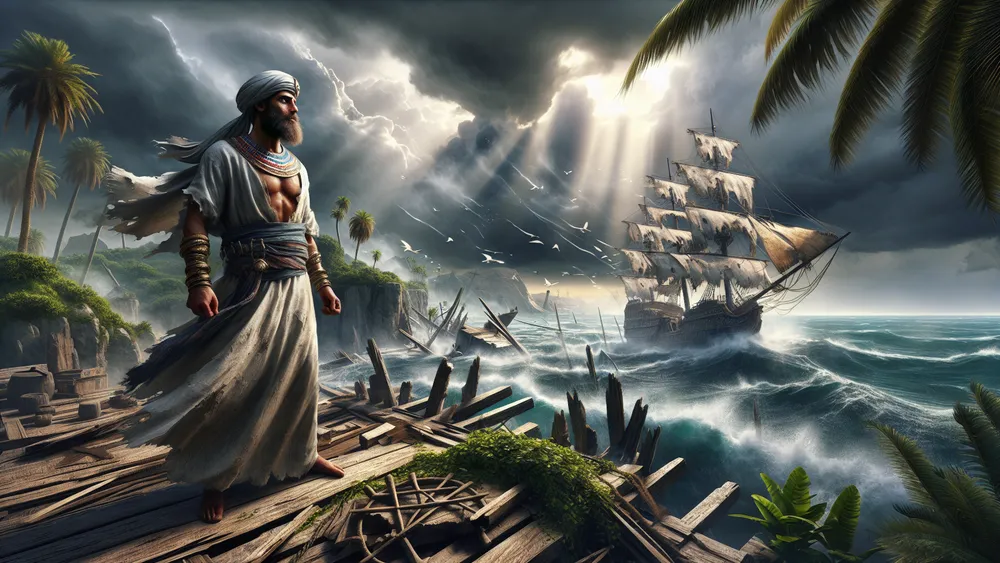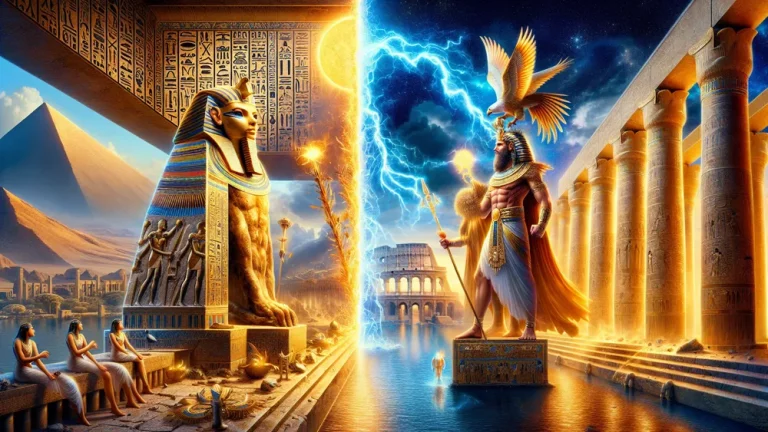The Story Of The Shipwreckd Sailor – An Ancient Egyptian Tale
Welcome to a look into one of ancient Egypt’s most interesting stories, “The Story of the Shipwrecked Sailor.” Imagine you set out on a big trip, only to end up stuck on a strange island, similar to characters lost in modern adventure tales.
Key Points:
- The Story of the Shipwreckd Sailor is an ancient Egyptian tale from the Middle Kingdom period.
- The story features a sailor who survives a shipwreck and receives wisdom from a talking serpent on a mysterious island.
- Themes in the tale include survival, resilience, divine intervention, and destiny.
- The sailor’s courage, adaptability, and resourcefulness are highlighted throughout the story.
- The serpent symbolizes wisdom and guidance, providing the sailor with valuable advice.
- The story offers a look into ancient Egyptian beliefs, emphasizing the role of gods, fate, and moral lessons.
- The Shipwreckd Sailor has had a long-lasting impact on storytelling and has influenced many later works.
This old story, kept for thousands of years, gives us a look into the ideas, beliefs, and ways of telling stories of ancient Egypt people. In this blog post, first, we dig into the story’s past, then find out the problems of changing its hieroglyphs into words we use, and lastly explore the deep themes and people in it that make this story never grow old.
If you know little about myths or know a lot, this trip through “The Story of the Shipwrecked Sailor” will be both eye-opening and fun.
The Story Of The Shipwrecked Sailor: Overview and Key Facts
| Key Point | Details |
|---|---|
| Title | The Story of the Shipwrecked Sailor |
| Where It’s From | Ancient Egypt |
| Time | Middle Kingdom period (c. 2040-1782 BCE) |
| When Found | They found it on an old paper in the 1800s |
| Language Used | Written in Middle Egyptian hieroglyphs |
| Type of Story | Adventure, Mythological Tale |
| Main Characters | The Sailor, The Serpent, The Pharaoh |
| Where It Happens | It starts with a trip and then things happen on a strange island |
| Story Summary | A sailor talks about crashing his ship and meeting a smart snake on an island |
| Themes | Survival, Wisdom, Divine Intervention, Resilience |
| Why It Matters | Shows what ancient Egyptians valued and how they told stories |
| How It’s Kept | Passed down by talking about it and saved on old paper |
| Problems in Understanding | Breaking down and understanding hieroglyphs and their old language |
| Story Message | Points out resilience, wisdom, and how fate matters in life |
The Tale’s History
To understand “The Story of the Shipwrecked Sailor,” it’s needed to know its background and the ways it was kept safe and read for many years.
Storytelling in Ancient Egypt
In old Egypt, storytelling was a vital way to keep history, give moral lessons, and build up religious beliefs. Just like telling family stories at dinner now, ancient Egyptians used stories to connect generations and teach values. Stories like “The Shipwrecked Sailor” were kept by talking and writing on old paper. By using both ways, they could pass stories down accurately for many years.
Covered in several main points, the importance of storytelling in old Egypt can be seen:
- Educational Tool: Stories taught young people about their past and right and wrong.
- Religious Significance: Many stories included divine help, showing the Egyptians’ religious beliefs.
- Social Cohesion: Telling stories helped strengthen community bonds and cultural identity.
Storytelling in ancient Egypt served as an educational tool, a way to express religious beliefs, and a means to strengthen community bonds.
Finding and Decoding the Tale
They found the story of “The Shipwrecked Sailor” on a old paper in the 19th century, when learning about Egypt was growing and many old writings were found. Finding an old paper showed a long lost story from Egypt. Much like finding an old paper at home with family stories, this old paper gave a valuable look into old Egyptian culture.
Changing the symbols was like solving a hard puzzle, needing scholars to carefully read every symbol and know its background. Scholars had many challenges, including knowing old language details and old culture that changed over many years.
The steps to read the story involved several key parts:

- Initial Discovery: Finding the paper and knowing it could be important.
- Hieroglyph Decoding: Changing the symbols to easy words.
- Contextual Interpretation: Knowing the culture and history to tell the story correctly.
The Story So Far
Since we have looked at the past background and the finding of the story, we should go deeper into the story itself and follow the sailor’s amazing trip.
The Adventure Begins: Setting Out
The story starts when the sailor goes on a big trip, probably sent by the Pharaoh, to see far places and bring back important items. Think about starting a long trip with big hopes and excitement, only to face unexpected problems. At first, the sailor had easy travel, with good weather and calm seas.

But then, trouble came when a big, violent storm showed up, shaking the ship around. In the end, the ship broke apart. The sailor was the only one left alive, holding on to a piece of the ship.
The things leading to the shipwreck can be summarized like this:
- Initial Voyage: The sailor starts a mission with a ready crew and ship.
- Sudden Storm: An unexpected storm causes chaos and breakage.
- Shipwreck: The ship breaks, and the sailor ends up alone in the big sea.
The Mysterious Island and the Wise Serpent
After living through the shipwreck, the sailor ends up on a strange island, where he meets a big snake. Think about getting lost in the thick woods and finding an old man who helps you; in the same way, the snake in this story is not a threat but a source of important advice.
The snake, who can talk, shares its own story of being the last one of its kind, showing a similarity to the sailor’s own trouble. By sharing its story, the snake shows it is important because it gives the sailor food, shelter, and good advice, making him more ready for his return to Egypt.
The importance of the snake in the story can be outlined as follows:
- Encounter: The sailor meets the snake on the island and fears it at first but soon sees it is friendly.
- Serpent’s Story: The snake shares its survival story, creating a bond with the sailor.
- Guidance and Wisdom: The snake gives practical help and good advice, guiding the sailor through his hard time.

Coming Home and the Pharaoh’s Response
When he gets back to Egypt, the sailor goes to the royal court to tell his amazing trip to the Pharaoh. Think about coming back from a hard trip and telling your experiences to a teacher; the sailor does just that. He talks about meeting the wise serpent and the lessons he learned. In the court, the Pharaoh listens closely.

He sees the sailor’s strength and the wisdom from the serpent. It is the Pharaoh who praises and rewards him. The moral of the story, which means strength, wisdom, and sharing experiences, is clear.
The main parts of this tale can be summed up like this:
- Return to Egypt: The sailor finds his way back home.
- Telling the Tale: He shares his trip with the Pharaoh, talking about the key things and lessons.
- Pharaoh’s Reaction: The Pharaoh notices the sailor’s courage and the wisdom he got, offering praise and rewards.
The sailor returns to Egypt, shares his adventure with the Pharaoh, and is praised and rewarded for his strength and wisdom.
Key Characters and What They Mean
After following the sailor’s journey and the Pharaoh’s response, we should look more at the main people and what they stand for in the story.
The Sailor: Resilience Personified
In the story “The Shipwrecked Sailor,” the sailor is a perfect show of strength and being flexible. Think of someone who looks at a series of hard challenges, yet stays strong and resourceful, like a person today getting through life obstacles. Through the story, the sailor shows great courage by living through the shipwreck, navigating the strange island, and talking with the wise snake.
His ability to adapt to new situations and learn from his experiences shows his strength.

The sailor’s qualities can be summarized as follows:
- Bravery: Facing the unknown with courage, especially during the shipwreck and on the island.
- Resourcefulness: Utilizing available resources and wisdom from the serpent to survive.
- Adaptability: Adjusting to new environments and situations, ultimately leading to his successful return to Egypt.
The Serpent: Symbol of Wisdom
In “The Shipwrecked Sailor,” the serpent is a strong show of wisdom and guidance. Think of a wise old person who gives wise advice to someone who needs it; the serpent does this part for the sailor. Its wisdom is clear in the way it gives not only food but also life lessons. The sailor gets help from the serpent to handle his problem and prepare for his return to Egypt. The importance of the serpent can be summarized as follows:
- Wisdom: The serpent shares deep thoughts and knowledge, which helps the sailor understand his situation better.
- Guidance: It gives practical advice and support, making sure the sailor survives and gets back safely.
- Symbolism: The serpent stands for the old Egyptian respect for wisdom and the belief in kind, guiding forces.
Main Themes and Ideas
After we looked at the main people and what they mean, we will now dig into the big ideas and things seen in “The Shipwrecked Sailor”.
Surviving Against the Odds
The theme of survival is clearly shown in “The Shipwrecked Sailor.” The main person’s trip is proof of human strength and the will to beat trouble. Imagine being stranded. No quick hope of help. The sailor lives this situation, showing his will to survive impossible odds. He can adapt to the tough conditions of the strange island. The wisdom given by the serpent, this shows the value of resilience. The lessons from his trip are:
- Adaptability: The sailor’s quick thinking and resourcefulness in a new place.
- Perseverance: His strong will to survive and get back home.
- Learning from Adversity: Gaining wisdom and strength from hard times.
Divine Helping Hand and Destiny
In “The Shipwrecked Sailor,” gods’ help and fate are mixed together in the story, showing what the old Egyptian people believed about gods’ help in human lives. Imagine feeling a guiding hand right when needed. The sailor sees the snake’s wisdom as a divine gift. The sailor’s staying alive and getting back to Egypt are shown as part of a big, planned path by the gods. This shows that the old Egyptians thought gods were deeply in their lives and that fate was a set path made by divine will. Key parts of this belief system include:
- Divine Guidance: The snake’s wisdom is a sign of gods’ help.
- Fate and Destiny: The sailor’s trip is shown as guided by a higher power, thus reflecting the belief in a set destiny.
- Religious Reverence: The story shows the importance of gods in daily life and their kind influence.
Cultural and Historical Impact
After we looked at the main ideas of the story, let’s now look into its cultural and historical importance in old Egyptian groups.
A Glimpse into Ancient Egyptian Life
“The Shipwrecked Sailor” offers an interesting look into the principles and beliefs of ancient Egyptian life, showing their deep respect for the gods, the importance of fate, and the moral lessons they valued. Think about living in a world where every event is seen as part of a divine plan. The sailor’s journey is guided by higher powers. The story shows that Egyptians thought the gods had a big role in their lives, and that destiny was decided by them. Socially, the story shows the tiered structure of Egyptian life, with the sailor going back to tell his adventure to the Pharaoh, showing the respect and loyalty to the ruler. Main aspects of ancient Egyptian life seen in the story include:
- Religious Beliefs: The gods being part of people’s lives and the idea of divine help.
- Fate and Destiny: The belief in a set path made by higher powers.
- Social Hierarchy: The respect and loyalty towards the Pharaoh and the set roles in the community.
The Tale’s Legacy
“The Shipwrecked Sailor” has had a lasting impact on books and stories, influencing many later works and shaping storytelling in Egypt and beyond. It is like an old fairy tale that still matters today. The story’s ideas about gods helping, fate, and not giving up are still important today, showing up in many different stories and myths. Its impact is seen in how it has been referenced and adapted in later Egyptian writings, and in world myths too. Main parts of its lasting impact include:

- Literary Impact: The story’s ideas and structure have inspired later books.
- Storytelling Traditions: How it changed the way stories are told, with moral lessons and divine parts.
- Cultural Resonance: The story’s ideas are still important in different cultures, showing common human experiences.
FAQs
1. What is the main message of The Shipwrecked Sailor?
The main message of “The Shipwrecked Sailor” is the importance of resilience and wisdom in overcoming adversity.
2. How was the tale of The Shipwrecked Sailor discovered?
The tale of “The Shipwrecked Sailor” was discovered on a Middle Kingdom papyrus, which was found in the early 19th century.
3. What are the key themes in The Shipwrecked Sailor?
The key themes in “The Shipwrecked Sailor” include survival, resilience, divine intervention, and destiny.
4. How does The Shipwrecked Sailor reflect ancient Egyptian beliefs?
“The Shipwrecked Sailor” reflects ancient Egyptian beliefs by illustrating themes of divine intervention, fate, and the importance of wisdom and resilience.







